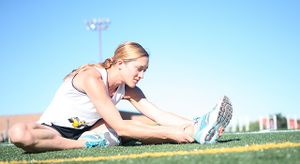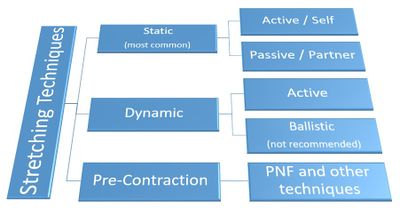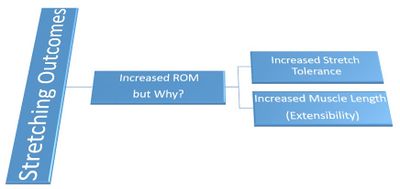Stretching
Purpose[edit | edit source]
Stretching exercises have traditionally been included as part of a training and recovery program. Evidence shows that physical performance in terms of maximal strength, number of repetitions and total volume are all affected differently by the each form of stretching – static stretch (SS), dynamic stretch (DS) and Pre-contraction stretching, Proprioceptive Neuromuscular Facilitation stretching (PNFS) being the most common type.[1][2]
Stretching can help improve flexibility and range of motion about your joints. Improved flexibility may: Improve your performance in physical activities; Decrease your risk of injuries; Help your joints move through their full range of motion; Enable your muscles to work most effectively[3]
Technique[edit | edit source]
Techniques of stretching include
Static Stretching[edit | edit source]
Static stretching (SS) is a type of stretching exercises in which elongation of muscle with application of low force and long duration (usually 30 sec).Static stretching has a relaxation, elongation effect on muscle,improving range of motion (ROM),decreasing musculotendinous stiffness and also reduces the risk of acute muscle strain injuries.[4] It is a slow controlled movement with emphasis on postural awareness and body alignment.It is suitable for all patient types.[5]
Dynamic Stretching[edit | edit source]
Dynamic Stretching (DS) involves the performance of a controlled movement through the available ROM. DS involves progressively increasing the ROM through successive movements till the end of the range is reached ie the stretch is repetitive and progressive. DS is good to use in advanced sports related rehabilitation and active sports persons.DS helps restore dynamic function and [[Neuromuscular Exercise Program |neuromuscular]] control through repeating and practicing movement thus enhancing motor control. DS is sometimes considered preferable to SS in the preparation for physical activity.[6]
DS activities help elevate core temperature increasing: nerve conduction velocity; muscle compliance and enzymatic cycling; accelerating energy production. DS more likely increase rather than decrease central drive,as may occur with prolonged SS.[1]
Pre-Contraction Stretching[edit | edit source]
This form of stretching involves a contraction of the muscle being stretched or its antagonist before stretching. PNF is the most common type, see below. Other types of pre-contraction stretching include “post-isometric relaxation” (PIR). This type of technique uses a much smaller amount of muscle contraction (25%) followed by a stretch. Post-facilitation stretch (PFS) is a technique developed by Dr Vladimir Janda that involves a maximal contraction of the muscle at mid-range with a rapid movement to maximal length followed by a 15-second static stretch.
Proprioceptive Neuromuscular Facilitation Stretching (PNFS)[edit | edit source]
Multiple PNF stretching techniques exist, all of them rely on stretching a muscle to its limit.This triggers the inverse myotatic reflex, a protective reflex that calms the muscle to prevent injury. Regardless of technique, PNF stretching can be used on most muscles in the body.PNFS can also be modified so you can do them alone or with a partner.[7]
The types of PNF stretch techniques are listed below,
- Contract Relax (CR) Contraction of the muscle through its spiral-diagonal PNF pattern,followed by stretch.
- Hold Relax (HR) Contraction of the muscle through the rotational component of the PNF pattern, followed by stretch.
- Contract-Relax Agonist Contract (CRAC) Contraction of the muscle through its spiral-diagonal PNF pattern, followed by contraction of opposite muscle to stretch target muscle.
Ballistic Stretching[edit | edit source]
Ballistic stretching includes rapid, alternating movements or ‘bouncing’ at end-range of motion; however, because of increased risk for injury, ballistic stretching is no longer recommended.[2]
The below video gives a brief description of the types of stretching ( isometric stretching here is similar to PNFS)
Mechanism of Muscle Stretching[edit | edit source]
The mechanism for the therapeutic effects of muscle stretching technique to improve range of motion could be explained using three models.
Biomechanical model[edit | edit source]
Literature suggests biomechanical models to explain the increase in muscle extensibility due to stretching based on muscle biomechanics, These include basically, Viscoelastic deformation and plastic deformation.[9]
Viscoelastic Deformation[edit | edit source]
Skeletal muscles are considered viscoelastic as they return to their original length once tensile force is removed.This extensibility is a viscoelastic deformation because its magnitude and duration are limited by muscles[9]. A study done on rabbit muscles suggests that muscle-tendon units respond viscoelastically to tensile loads and reflex activities did not influence the biomechanical characteristics of the model[10]
Plastic Deformation[edit | edit source]
This theory suggests that when a stretch intensity is adequate to elongate connective tissues past their elastic limit, they are deformed permanently as they attain the plastic phase of stretch elongation.[9]. This model lacks comprehensive evidence to support it.
Sensory Model[edit | edit source]
Sensory modulation and a change in subject's perception of sensation is attributed to changes in range of motion due to stretching. [9], This theory is referred to as the sensory theory, Sensation such as pain, stretch etc that inhibits range of motion could then be tolerated after stretching.
Neural Model[edit | edit source]
Inhibitory effects on monosynaptic spinal reflexes due to muscle stretching is present in both the stretched and non-stretched muscles of the ipsilateral leg. This could partly be explained by the inhibition by afferent inputs from muscle receptors (Muscle Spindle and Golgi Tendon Organ) on spinal reflexes[11]. The motor neural pool are known to reduce after 30 sessions of stretching and partly contributes to a gain in flexibility[12]. A systematic review of the effectiveness for the treatment and prevention of contractures in people with neurological conditions concluded that regular stretch does not produce clinically important changes in joint mobility,pain, spasticity or activity limitation in people with neurological conditions.[13]
indication of stretching[edit | edit source]
- ROM is limited because soft tissues have lost their extensibility as the result of adhesions, contractures, and scar tissue formation, causing activity limitations (functional limitations) or participation restrictions (disabilities).
- The restricted motion may lead to structural deformities that are otherwise preventable.
- Muscle weakness and shortening of opposing tissue have led to limited ROM.
- Maybe a component of a total fitness or sport-specific conditioning program designed to prevent or reduce the risk of musculoskeletal injuries.
- May be used prior to and after vigorous exercise to potentially reduce post-exercise muscle soreness
Contraindications to Stretching[edit | edit source]
- Bony block on end of range (EOR) on passive assessment
- Unstable/recent fracture
- Acute soft tissue injury
- Infection/haematoma in tissues
- Post surgical repairs e.g, skin grafts, tendon repair
- Hypermobility
- Client refusal
Evidence[edit | edit source]
A 2012 study on the evidence surrounding stretching techniques found that the benefits of stretching seem to be individual to the population studied.To increase ROM, all types of stretching are effective, although PNF-type stretching may be more effective for immediate gains.To avoid decrease in strength and performance that may occur in athletes due to static stretching before competition or activity, dynamic stretching is recommended for warm-up.Older adults over 65 years old should incorporate static stretching into an exercise regimen.A variety of orthopedic patients can benefit from both static and pre-contraction stretching.[2]
Outcome[edit | edit source]
Increased ROM as a result of stretching exercises can be a result of patients/athletes ability to withstand more stretching force or a real increase in muscle length [2]."İncreased stretch tolerance" term is used for ability to withstand more stretching force.Increased muscle length or increased extensibility terms are used for real increase in muscle length.Measurement of passive ROM is not sufficient to measure extensibility. Passive ROM should be measured with reference loads to identify increased stretch tolerance and increased extensibility.
Physiotherapy- Important Messages To Remember for Stretching[edit | edit source]
- To increase joint range of motion,all types of stretching are effective,although PNF-type stretching may be more effective for immediate gains.
- Dynamic stretching is recommended for warm-up for athletes before competition or activity.As static stretching will likely decrease strength and may influence performance.[14]
- Post exercise static stretching or Proprioceptive Neuromuscular Facilitation stretching is recommended for reducing muscle injuries and increasing joint range of motion.[15] Although Stretching has not been shown to be effective at reducing the incidence of overall injuries.
- Stretching is often included in Physiotherapy interventions for management of many kinds of clinical injuries.Despite positive outcomes,it is difficult to isolate the effectiveness of the stretching component of the total treatment plan because the protocols usually include strengthening and other interventions in addition to stretching.[1]
References[edit | edit source]
- ↑ 1.0 1.1 1.2 POGO An evidence based guide to stretching Available from: https://www.pogophysio.com.au/blog/performance-maximisation/ (last accessed 1.6.2019)
- ↑ 2.0 2.1 2.2 2.3 Page P. Current concepts in muscle stretching for exercise and rehabilitation. International journal of sports physical therapy. 2012 Feb;7(1):109. Available from: https://www.ncbi.nlm.nih.gov/pmc/articles/PMC3273886/ (last accessed 1.6.2019)
- ↑ Mayo Clinic Stretching Available from: https://www.mayoclinic.org/healthy-lifestyle/fitness/in-depth/stretching/art-20047931 (last accessed 1.6.2019)
- ↑ Physiopedia Impact of static stretching on muscle performance Available from: https://www.physio-pedia.com/Impact_of_Static_Stretching_on_Performance (last accessed 1.6.2019)
- ↑ Kay AD, Blazevich AJ. Effect of acute static stretch on maximal muscle performance: a systematic review. Medicine & Science in Sports & Exercise®. 2012 Jan 1;44(1):154-64. Available from: https://insights.ovid.com/medicine-science-sports-exercise/mespex/2012/01/000/effect-acute-static-stretch-maximal-muscle/20/00005768 (last accessed 3.6.2019)
- ↑ Mason D Exercise in rehabilitation In: Porter S Tidy's Physiotherapy Sydney Elsevier 2013 pages 281-284
- ↑ Healthline PNF stretching Available from: https://www.healthline.com/health/fitness-exercise/pnf-stretching#pnf-techniques (last accessed 1.6.2019)
- ↑ Rachael Goepper Types of stretching Available from: https://www.youtube.com/watch?v=3V_L7ArBn_A (last accessed 1.6.2019)
- ↑ 9.0 9.1 9.2 9.3 Weppler CH, Magnusson SP. Increasing muscle extensibility: a matter of increasing length or modifying sensation?. Physical therapy. 2010 Mar 1;90(3):438-49.
- ↑ Taylor DC, Dalton JR JD, Seaber AV, Garrett JR WE. Viscoelastic properties of muscle-tendon units: the biomechanical effects of stretching. The American journal of sports medicine. 1990 May;18(3):300-9.
- ↑ Masugi Y, Obata H, Inoue D, Kawashima N, Nakazawa K. Neural effects of muscle stretching on the spinal reflexes in multiple lower-limb muscles. PloS one. 2017;12(6).
- ↑ Guissard N, Duchateau J. Neural aspects of muscle stretching. Exercise and sport sciences reviews. 2006 Oct 1;34(4):154-8.
- ↑ Katalinic OM, Harvey LA, Herbert RD. Effectiveness of stretch for the treatment and prevention of contractures in people with neurological conditions: a systematic review. Physical therapy. 2011 Jan 1;91(1):11-24.
- ↑ Shrier I. Does stretching improve performance?: a systematic and critical review of the literature. Clinical Journal of sport medicine. 2004 Sep 1;14(5):267-73. Available from: https://insights.ovid.com/clinical-sport-medicine/cjspm/2004/09/000/does-stretching-improve-performance-systematic/4/00042752 (last accessed 3.6.2019)
- ↑ Sharman MJ, Cresswell AG, Riek S. Proprioceptive neuromuscular facilitation stretching. Sports medicine. 2006 Nov 1;36(11):929-39. Available from: https://www.ncbi.nlm.nih.gov/pubmed/17052131 (last accessed 3.6.2019)









